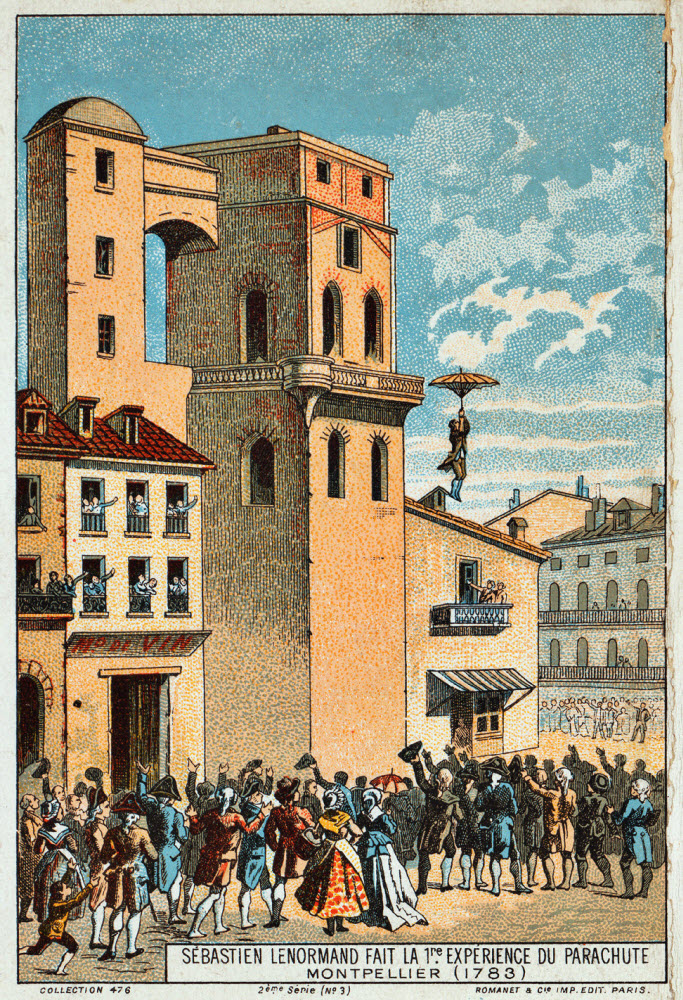On December 26, 1783, a crowd gathered outside the observatory in Montpellier, a French city near the south coast on the Mediterranean Sea. They were about to witness the world’s first successful jump in a parachute.
The observatory was housed inside a tall mediaeval tower known as “Tour de la Babotte”. It is one of only two towers that survive from a time when Montpellier was encircled by ramparts. The tower is some 26 meters tall, and for a while it had been used as an observatory to study celestial phenomenon such as eclipses. But that December afternoon, the tower was being used for an entirely earthly purpose.

Louis-Sébastien Lenormand, the son of a clockmaker, was about to make a demonstration. He had engineered a contraption that would allow people to jump from burning buildings and land safely on the ground unhurt. His device consisted of two umbrellas attached together to a rigid wooden frame. Lenormand had been practicing the jump for quite sometime from a lesser height—the upper branches of an elm tree. He also tested his apparatus with animals, before he was confident enough to try it on himself.
On the appointed day, Lenormand appeared at the top of the tower. He waved briefly at the gathering crowd that was growing eager by the minute. On a cue, he grabbed the handle of his gigantic umbrella and jumped.
Lenormand did not invent the parachute—he was just the first one to trust his life on an idea that had existed for thousands of years. The earliest account of parachutes were fictional. The Western Han Dynasty writer Sima Qian recounts the story of Shun, a legendary Chinese emperor who ran away from his murderous father by climbing onto the top of a high granary and leaping to safety by grabbing two bamboo hats.
The oldest depiction of a parachute appears in an anonymous manuscript from 1470s Italy, showing a free-hanging man clutching a cross bar frame attached to a conical canopy.

A decade later, a more sophisticated parachute was sketched by Leonardo da Vinci, where the canopy was held open by a square wooden frame instead of a conical one. The sketch was accompanied by a description: “If a man have a tent made of linen of which the apertures (openings) have all been stopped up, and it be twelve braccia (about 23 feet) across and twelve in depth, he will be able to throw himself down from any great height without suffering any injury.”
The Dalmatian inventor Fausto Veranzio (1551–1617) examined da Vinci's parachute sketch and kept the square frame but replaced the canopy with a bulging sail-like piece of cloth that he discovered decelerates a fall more effectively. In a famous depiction of his parachute design, titled Homo Volans (“Flying Man”), Veranzio shows a man parachuting from a tower, presumably St Mark's Campanile in Venice. This sketch had led many historians to believe that Veranzio, then 65 and seriously ill, had actually tested his design by jumping from St Mark's Campanile. But the lack of any written evidence suggest that the event never occurred, and the sketch was only a representation.

"Homo Volans", an illustration by Faust Vrančić, depicting an early parachute of his own design.
Two years after Lenormand’s parachute jump in Montpellier, he coined the word “parachute”, from the Italian prefix para meaning "against” and the French word chute for “fall”, to describe the device's actual function.
Improvements in the parachute’s design progressed rapidly since Lenormand’s demonstration. In 1785, the same year Lenormand coined the word parachute, Jean-Pierre Blanchard demonstrated, with a dog, the parachute as a means of safely disembarking from a hot-air balloon. In 1793, Blanchard had the opportunity to test the trustworthiness of the parachute himself when his balloon ruptured. Blanchard also began making collapsible parachutes from folded silk instead of linen stretched over a wooden frame. In 1797, André Garnerin made the first descent of a “frameless” parachute covered in silk. The place he landed is now marked with a plaque.

Garnerin releases the balloon and descends with the help of a parachute, 1797.

Schematic depiction of Garnerin's first parachute used in the Parc Monceau descent of 22 October, 1797.
Nothing significant happened for the next one hundred years, until Charles Broadwick demonstrated two key advances in the parachute in the early 20th century. He folded his parachute into a pack which he wore on his back and the parachute was pulled from the pack by a static line attached to a hot air balloon. When Broadwick jumped from the balloon, the static line became taut, pulled the parachute from the pack, and then snapped. This integrated, form-fitting harness and container system, that could be worn on the back became the standard on all modern parachute system. Static line parachutes are still used by paratroops today.












Comments
Post a Comment